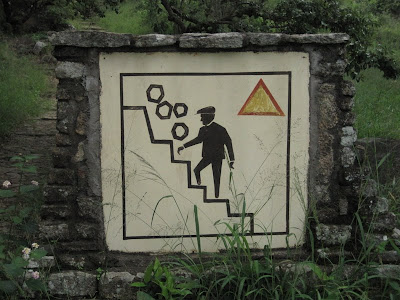Why this amused me? I don't know. It's a flaming billy club!
We welcomed Great Zimbabwe's sprawling emptiness, aside from the tinges of pity towards the armies of idle hospitality staff and overalled men raking the same patch of soil day after day. Though the term doesn't usually bring to mind anything outside Europe, GZ is indeed a medieval city, dating back almost one thousand years, and is the largest ancient structure in sub-Saharan Africa, home to 20,000 at its peak. Research shows the sophisticated structures were built by the local Bantu people of the area (though colonial authorities of yesteryear were eager to prove otherwise) and there is much evidence pointing to healthy trade routes through Mozambique and beyond – a museum displays ornate artifacts from India, Persia and China, all excavated from the ruins. Also in the museum are a set of treasured soapstone birds, one of which is reproduced on the country's flag. Their significance as national emblems was offset somewhat by their being modestly propped within a dim, stuffy papier-mache 'cave' diorama, dead moss glued to the walls.
Watch out, mid-century British man!
The ruins themselves are epic. Divided into two 'enclosures,' one laid whimsically on the peak of a huge stone 'whaleback' and the other more bulky and spread out within a valley, they satisfy all the criteria for a good castle romp: winding passageways, narrow doors, and the sense that you're the first to move among their walls in centuries. What differentiates Great Zimbabwe from similar European structures is their classification as 'free-stone,' meaning no mortar or sealant was used in their construction. Everything we explored was built of stacked, free-standing granite, at times two meters thick and eleven meters high, and all we had for company were a community of blue-tailed lizards and more loftily dropped baboon dung.
Making use of the natural landscape in the Upper Enclosure
Poo with a view
While the state of Zimbabwe's tourism economy sometimes overshadows the sights themselves (in commenting about our visit since, “we were all alone!” is often the first thing from out mouths), visiting the ruins was an affirmation of what the country has to offer – we visited a solid, world-class attraction, with a singularity and historical resonance that no game lodge or snake park can match. So please, come to Zimbabwe! And maybe do a little littering while you're here, or scuff a footpath at least – tell the groundskeepers Scott sent you.
















1 comment:
Wow! What an adventure. The huge stone walls are amazing.
Post a Comment